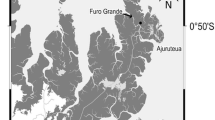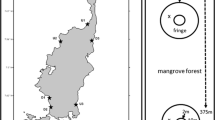Abstract
To clarify the effects of crab burrows on variation in sediment CO2 flux in mangrove forest, we measured the traits of crab burrows (density and entrance area size) and the CO2 flux rate from sediment surfaces, in areas with and without burrows, in a subtropical mangrove forest on Ishigaki Island, southwestern Japan. Burrow density and entrance area showed significant differences among seasons (warm, middle, and cool) and mangrove zones (upper-, middle-, and downstream), which may have depended on crab phenology, life cycle, and species composition. The sediment CO2 flux rate was significantly higher at plots with crab burrows (B+) than at those without burrows (B−) in each zone and season. However, standardized sediment CO2 flux rate by burrow surface area at B+ plots did not differ significantly from that at B− plots. In addition, there were no significant differences in sediment temperature and sediment water content between the two types of plots. Moreover, the level of microbial respiration differed significantly between sediments collected from the deep part and those collected from either the ground surface part or burrow walls. These results suggest that crab burrows increase sediment CO2 flux from the mangrove forest floor by increasing the sediment–atmosphere interface area, thereby inducing a change to aerobic conditions in the sediments around burrows. Therefore, the seasonal and spatial effect of crab burrows on the forest floor should be considered when evaluating sediment CO2 flux and examining the role of the mangrove ecosystem as a carbon sink.






Similar content being viewed by others
References
Alongi, D.M. 2014. Carbon cycling and storage in mangrove forests. Annual Review of Marine Science 6: 195–219.
Alongi, D.M., G. Wattayakorn, J. Pfitzner, F. Tirendi, I. Zagorskis, G.J. Brunskill, A. Davidson, and B.F. Clough. 2001. Organic carbon accumulation and metabolic pathways in sediments of mangrove forests in southern Thailand. Marine Geology 179: 85–103.
Alongi, D.M., N.A. de Carvalho, A.L. Amaral, A. da Costa, L. Trott, and F. Tirendi. 2012. Uncoupled surface and below-ground soil respiration in mangroves: implications for estimates of dissolved inorganic carbon export. Biogeochemistry 109: 151–162.
Barr, J.G., V. Engel, J.D. Fuentes, J.C. Zieman, T.L. O’Halloran, T.J. Smith III, and H.F. Anderson. 2010. Controls on mangrove forest–atmosphere carbon dioxide exchanges in western Everglades National Park. Journal of Geophysical Research 115: G02020.
Bowden, R.D., K.M. Newkirk, and G.M. Rullo. 1998. Carbon dioxide and methane fluxes by a forest soil under laboratory-controlled moisture and temperature conditions. Soil Biology and Biochemistry 30: 1591–1597.
Breithaupt, J.L., J.M. Smoak, T.J. Smith III, C.J. Sanders, and A. Hoare. 2012. Organic carbon burial rates in mangrove sediments: strengthening the global budget. Global Biogeochemical Cycles 26: GB3011.
Chanda, A., A. Akhand, S. Manna, S. Dutta, I. Das, S. Hazra, K.H. Rao, and V.K. Dadhwal. 2014. Measuring daytime CO2 fluxes from the inter-tidal mangrove soils of Indian Sundarbans. Environmental Earth Sciences 72: 417–427.
Cleveland, C.C., D.R. Nemergut, S.K. Schmidt, and A.R. Townsend. 2007. Increases in soil respiration following labile carbon additions linked to rapid shifts in soil microbial community composition. Biogeochemistry 82: 229–240.
Davidson, E.A., L.V. Verchot, J.H. Cattânio, I.L. Ackerman, and J.E.M. Carvalho. 2000. Effects of soil water content on soil respiration in forests and cattle pastures of eastern Amazonia. Biogeochemistry 48: 53–69.
Dye, A.H., and T.A. Lasiak. 1987. Assimilation efficiencies of fiddler crabs and deposit-feeding gastropods from tropical mangrove sediments. Comparative Biochemistry and Physiology 87: 341–344.
Franzluebbers, A.J. 1999. Potential C and N mineralization and microbial biomass from intact and increasingly disturbed soils of varying texture. Soil Biology and Biochemistry 31: 1083–1090.
Hanson, P.J., N.T. Edwards, C.T. Garten, and J.A. Andrews. 2000. Separating root and soil microbial contributions to soil respiration: a review of methods and observations. Biogeochemistry 48: 115–146.
Ishigami, T., K. Irie, and T. Ishikawa. 2005. Estimation of crustacean habitat distribution by counting their burrow on Amparu tidal flat, Ishigaki Island [in Japanese, with English Abstract]. Annual Journal of Hydraulic Engineering 49: 1489–1494.
Jin, L., C.Y. Lu, Y. Ye, and G.F. Ye. 2013. Soil respiration in a subtropical mangrove wetland in the Jiulong River estuary, China. Pedosphere 23: 678–685.
Jones, C.G., J.H. Lawton, and M. Shachak. 1994. Organisms as ecosystem engineers. Oikos 69: 373–386.
Jordan, T.E., and I. Valiela. 1982. A nitrogen budget of the ribbed mussel, Geukensia demissa, and its significance in nitrogen flow in a New England salt marsh. Limnology and Oceanography 27: 75–90.
Kida, M., M. Tomotsune, Y. Iimura, K. Kinjo, T. Ohtsuka, and N. Fujitake. 2017. High salinity leads to accumulation of soil organic carbon in mangrove soil. Chemosphere 177: 51–55.
Kinjo, K., Y. Tokashiki, K. Sato, M. Kitou, and M. Shimo. 2005. Characteristics of surface sediments along a creek in a mangrove forest. Soil Science and Plant Nutrition 51: 809–817.
Kinoshita, K., M. Wada, K. Kogure, and T. Furota. 2003. Mud shrimp burrows as dynamic traps and processors of tidal-flat materials. Marine Ecology Progress Series 247: 159–164.
Komiyama, A., J.E. Ong, and S. Poungparn. 2008. Allometry, biomass, and productivity of mangrove forests: a review. Aquatic Botany 89: 128–137.
Kosuge, T. 2013. Breeding season of the fiddler crab Uca jocelynae Shih, Naruse & Ng in the Fukido River, Ishigaki Island, Ryukyu Islands, southern Japan. Japanese Journal of Nankiseibutsu 53: 51–54.
Kosuge, T., and H. Kohno. 2010. Breeding season of the soldier crab, Mictyris brevidactylus (Crustacea, Brachyura, Mictyridae) in Urauchi River, Iriomote Island. Bulletin of Institute of Oceanic Research and Development, Tokai University 31: 43–50.
Kristensen, E., M.R. Flindt, S. Ulomi, A.V. Borges, G. Abril, and S. Bouillon. 2008. Emission of CO2 and CH4 to the atmosphere by sediments and open waters in two Tanzanian mangrove forests. Marine Ecology Progress Series 370: 53–67.
Laverock, B., C.J. Smith, K. Tait, A.M. Osborn, S. Widdicombe, and J.A. Gilbert. 2010. Bioturbating shrimp alter the structure and diversity of bacterial communities in coastal marine sediments. The ISME Journal 4 (12): 1531–1544.
Lawton, J.R., A. Todd, and D.K. Naidoo. 1981. Preliminary investigations into the structure of the roots of mangroves, Avicennia marina and Bruguiera gymnorrhiza, in relation to ion uptake. The New Phytologist 88: 713–722.
Lee, S.Y. 1997. Potential trophic importance of the faecal material of the mangrove sesarmine crab Sesarma messa. Marine Ecology Progress Series 159: 275–284.
Li, W., L. Cui, M. Zhang, Y. Wang, Y. Zhang, Y. Lei, and X. Zhao. 2015. Effect of mangrove restoration on crab burrow density in Luoyangjiang Estuary, China. Forest Ecosystems 2 (1): 21–29. https://doi.org/10.1186/s40663-015-0046-3.
Mall, L.P., P.V. Singh, and A. Garge. 1991. Study of biomass, litter fall, litter decomposition and soil respiration in monogeneric mangrove and mixed mangrove forests of Andaman Islands. Journal of Tropical Ecology 32: 144–152.
Myers, A.C. 1979. Summer and winter burrows of a mantis shrimp, Squilla empusa, in Narragansett Bay, Rhode Island (USA). Estuarine and Coastal Marine Science 8: 87–98.
Nielsen, O.I., E. Kristensen, and D.J. Macintosh. 2003. Impact of fiddler crabs (Uca spp.) on rates and pathways of benthic mineralization in deposited mangrove shrimp pond waste. Journal of Experimental Marine Biology and Ecology 289: 59–81.
Otani, T., T. Yamaguchi, and T. Takahashi. 1997. Population structure, growth and reproduction of the fiddler crab, Uca arcuata (De Haan). Crustacean Research 26: 109–124.
Otani, S., Y. Kozuki, R. Yamanaka, H. Sasaoka, T. Ishiyama, Y. Okitsu, H. Sakai, and Y. Fujiki. 2010. The role of crabs (Macrophthalmus japonicus) burrows on organic carbon cycle in estuarine tidal flat, Japan. Estuarine, Coastal and Shelf Science 86: 434–440.
Poungparn, S., and A. Komiyama. 2013. Net ecosystem productivity studies in mangrove forests. Reviews in Agricultural Science 1: 61–64.
Poungparn, S., A. Komiyama, A. Tanaka, T. Sangtiean, C. Maknual, S. Kato, P. Tanapermpool, and P. Patanaponpaiboon. 2009. Carbon dioxide emission through soil respiration in a secondary mangrove forest of eastern Thailand. Journal of Tropical Ecology 25: 393–400.
Poungparn, S., A. Komiyama, T. Sangteian, C. Maknual, P. Patanaponpaiboon, and V. Suchewaboripont. 2012. High primary productivity under submerged soil raises the net ecosystem productivity of a secondary mangrove forest in eastern Thailand. Journal of Tropical Ecology 28: 303–306.
Pülmanns, N., K. Diele, U. Mehlig, and I. Nordhaus. 2014. Burrows of the semi-terrestrial crab Ucides cordatus enhance CO2 release in a North Brazilian mangrove forest. PLoS One 9: e109532.
Qureshi, N.A., and N.U. Saher. 2012. Burrow morphology of three species of fiddler crab (Uca) along the coast of Pakistan. Belgian Journal of Zoology 142: 114–126.
Robertson, A.I., P.A. Daniel, and P. Dixon. 1991. Mangrove forest structure and productivity in the Fly River estuary, Papua New Guinea. Marine Biology 111: 147–155.
Ross, M.S., P.L. Ruiz, G.J. Telesnicki, and J.F. Meeder. 2001. Estimating above-ground biomass and productivity in mangrove communities of Biscayne National Park, Florida (USA). Wetlands Ecology and Management 9: 27–37.
Sasaki, A., H. Nakao, S. Yoshitake, and T. Nakatsubo. 2014. Effects of the burrowing mud shrimp, Upogebia yokoyai, on carbon flow and microbial activity on a tidal flat. Ecological Research 29: 493–499.
Scholander, P.F., L. van Dam, and S.I. Scholander. 1955. Gas exchange in the roots of mangroves. American Journal of Botany 42: 92–98.
Sherman, R.E., T.J. Fahey, and P. Martinez. 2003. Spatial patterns of biomass and above-ground net primary productivity in a mangrove ecosystem in the Dominican Republic. Ecosystems 6: 384–398.
Shih, H.-T. 2012. Distribution of fiddler crabs in East Asia, with a note on the effect of the Kuroshio Current. Kuroshio Science 6: 83–89.
Tomotsune, M., R. Masuda, S. Yoshitake, T. Anzai, and H. Koizumi. 2013a. Seasonal and inter-annual variations in contribution ratio of heterotrophic respiration to soil respiration in a cool-temperate deciduous forest. The Journal of Geography [Chigaku Zasshi] 122: 745–754.
Tomotsune, M., S. Yoshitake, S. Watanabe, and H. Koizumi. 2013b. Separation of root and heterotrophic respiration within soil respiration by trenching root biomass regression, and root excising methods in a cool-temperate deciduous forest in Japan. Ecological Research 28: 259–269.
Tomotsune, M., Y. Suzuki, T. Ohtsuka, S. Yoshitake, N. Suminokura, H. Shinkai, and H. Koizumi. 2017. Measurement of carbon efflux from exposed and submerged sediment surfaces using the automatic open/close chamber method in a mangrove forest – A challenge to clarify carbon dynamics in the pedosphere. Japanese Journal of Ecology 67: 75–83.
Tomotsune, M., S. Yoshitake, Y. Iimura, M. Kida, N. Fujitake, H. Koizumi, and T. Ohtsuka. 2018. Effects of soil temperature and tidal condition on variation in carbon dioxide flux from soil sediment in a subtropical mangrove forest. Journal of Tropical Ecology 34: 268–275.
Tomlinson, P.B. 1986. The botany of mangroves. Cambridge: Cambridge University Press.
Warren, J.H. 1990. Role of burrows as refuges from subtidal predators of temperate mangrove crabs. Marine Ecology Progress Series 67: 295–299.
Acknowledgements
We thank Dr Iimura, University of Shiga Prefecture, and Dr Kondo, National Institute for Environmental Studies, for their help with fieldwork and their valuable advice. We also thank the laboratory members at Gifu University, Kobe University, and Waseda University for their assistance with field measurements as well as many constructive discussions. We thank the Edanz Group (www.edanzediting.com/ac) for editing a draft of this manuscript.
Author information
Authors and Affiliations
Corresponding author
Additional information
Communicated by Marco Bartoli
Rights and permissions
About this article
Cite this article
Tomotsune, M., Arai, H., Yoshitake, S. et al. Effect of Crab Burrows on CO2 Flux from the Sediment Surface to the Atmosphere in a Subtropical Mangrove Forest on Ishigaki Island, Southwestern Japan. Estuaries and Coasts 43, 102–110 (2020). https://doi.org/10.1007/s12237-019-00667-2
Received:
Revised:
Accepted:
Published:
Issue Date:
DOI: https://doi.org/10.1007/s12237-019-00667-2




